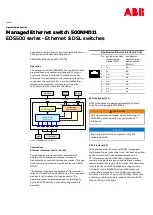
5. Multicast > Multicast Group Tables
110
Tsi578 User Manual
June 6, 2016
Integrated Device Technology
www.idt.com
9.
Once in the egress buffer, the packet copies are subjected to STOMP (
), and packet reordering. The packet copies at each egress ports are transmitted out
from the egress buffer independent of each port.
When packets are being transferred in cut-through mode, it is possible for the packet to have an error
detected in it (that is, CRC), or for the packet to be STOMPed by the RapidIO link partner. In these
cases, the packet is still accepted and replicated by the multicast work queue and stored in the
broadcast buffers. The last datum in the packet is marked with a STOMP bit in the multicast work
queue, the broadcast buffer, and the egress port buffer so that the packet is stomped when it is sent out.
5.2
Multicast Group Tables
Each ingress RapidIO port on the Tsi578 contains a multi-stage lookup table. The Tsi578 compares the
incoming packet’s destination ID and TT field to the entries in the lookup table to determine the correct
egress port. The destination ID and TT field in the packet uniquely identify a multicast group. The
destination ID/TT number space for multicast groups is shared with the number space for unicast
destinations.
The first stage of the lookup table contains eight entries used only for multicast packets, and is called
the
multicast group table
. This group table resides in both the ingress ports and the multicast engine.
An entry is configured either to match a 16-bit destination ID (TT=0) or an 8-bit destination ID
(TT=1). For example, to match both the 8-bit destination ID of five and the 16-bit destination ID of five
requires two entries in the multicast group table. If the destination ID contained in an incoming packet
matches any of the eight entries, the ingress port sends the packet to the multicast engine for
replication.
The matching table entry contains a list of ports (multicast mask) to which the multicast engine sends a
copy of the packet. However, a packet copy is never sent out from the port that the original packet was
received on, regardless of the contents of the port list.
At the ingress port, if none of the multicast destination IDs in the group table match the packet’s
destination ID, the Tsi578 assumes the packet is a unicast packet and consults the unicast lookup table.
The eight entries in the multicast group table are configured in a multi-step process:
1.
Add a set of ports to one of eight multicast masks through repeated writes to the Multicast Mask
Configuration Register. The Tsi578 silently ignores attempts to configure masks greater than the
mask number. The mask number is defined with the MAX_MASKS field of the
Multicast Information CAR” on page 257
.
2.
Write the destination ID that identifies the multicast group, and the multicast mask number from
the previous step to the
“RapidIO Multicast DestID Configuration Register” on page 265
System behavior which requires responses from multicast packets is not defined in the
RapidIO Interconnect Specification (Revision 1.3)
.
The Tsi578 silently ignores attempts to add or remove non-existent port numbers to/from
multicast masks. A non-existent port number is a port number greater than that which exists
on the device. For the Tsi578, port numbers greater than 15 are ignored. It is possible to add
and remove powered down or otherwise disabled ports to/from the multicast masks.
















































